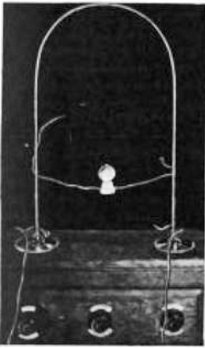Image: High frequency inductance experiment 1906
Description: Experiment by high voltage expert Earle Ovington at the December 1906 electric trade show at Madison Square Garden, New York City, reported by Archie Frederick Collins, demonstrating that high frequency currents behave differently from ordinary DC or low frequency AC current. The output terminals of a Tesla coil are connected to a copper bar with a U shaped bend in it. The bar has negligible resistance so at low frequencies the current would flow through it, leaving the light unlit. However at radio frequency the bend gives the bar enough inductive reactance that there is a potential difference of hundreds of volts across it, and the current instead flows through the higher resistance of the incandescent lamp's filament, lighting it. At the turn of the century this counterintuitive behavior was startling to electrical engineers, who were more familiar with DC and low frequency AC currents. Caption: LIGHTING AN INCANDESCENT LAMP SHORT-CIRCUITED WITH HEAVY COPPER The current has the choice of two paths - an easy one through the copper bar, and a higher resistance one through the lamp - and it chooses the latter. Ordinary current would take the easier path
Title: High frequency inductance experiment 1906
Credit: Retrieved December 1, 2015 from Archie Frederick Collins, "High-Potential Discharges" in Scientific American magazine, Munn and Co., New York, Vol. 94, No. 4, January 27, 1906, p. 92 on Google Books
Author: Archie Frederick Collins
Usage Terms: Public domain
License: Public domain
Attribution Required?: No
Image usage
The following page links to this image:


